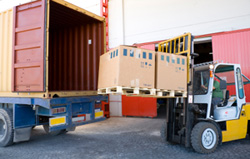
It seems like an uphill battle – constantly looking for ways to control and even reduce costs – but it’s a very real one that all businesses must fight on a daily basis. An in-depth review of the supply chain is sure to reveal at least a few inefficiencies that, with proper planning, could be eliminated. Believe it or not, this assessment, and ultimately optimization, of your supply chain could yield significant savings.
Optimization includes, among other things, evaluating three main components of the supply chain – transportation, network and inventory – to produce the most efficient plan to source, transport, hold and distribute product (raw or finished goods). In its most basic form, supply chain optimization is the evaluation of modes, carriers and routes; capacity constraints and sizing of facilities; inventory levels and drivers; supply; customer demand; and customer service policies.
It is important for e-tailers to be constantly reviewing their supply chains because, over time, inefficiencies begin to develop in networks, says Dennis R. Estep, senior director of UPS Customer Solutions.
One such common inefficiency is in inventory positioning. It is important to correctly position and minimize inventory in the supply chain. After all, inventory that is stocked in a distribution facility, or in transit between facilities and to the customer, produces no revenue for an e-tailer. Additionally, excess inventory and stock-outs introduce further inefficiencies to the supply chain.
Inventory may shift from one distribution facility to another because of inconsistent order and replenishment policies. For example, an e-tailer with warehouses in New York and California might begin to ship product to customers in New Jersey from the California facility because the New York facility does not have enough of that product in stock.
Instead of being an exception, over time, shipping product from California to New Jersey customers becomes a common practice. This shift happens so gradually that operations and fulfillment executives may be unaware that it is happening or the extent of it. Before executives realize it, a substantial amount of New Jersey customers’ demand is being shipped from California.
“We’re crossing over transportation lanes because we have inventory sitting in the wrong location,” Estep says. “That is a common practice. The supply chain devolves because of the way products are ordered, the way we service products from vendors and suppliers, and the way that customer orders are handled.”
What that does is increase the amount of money an e-tailer spends on transportation.
“Your inventory is in the wrong spot and that causes you to increase your shipping costs,” Estep points out.
Supply chain optimization would be able to spot this cost-prohibitive practice by creating visual and quantitative displays of product flow and inventory positions, and identifying the allocation of supply chain costs to the three major categories: inbound-outbound transportation costs, warehousing costs and inventory costs.
“We show the lines of distribution for the transportation between facilities and to customers, then the costs associated with that transportation,” Estep says.
Warehouse site location is also a critical part of supply chain optimization. That might mean shutting one warehouse and opening another in a different location. The question that has to be answered before this decision is made, according to Estep, is whether this would help trim transportation and warehousing costs or make a minimal impact.
One company with six distribution facilities nationwide and $120 million in supply chain costs projected that those costs were going to increase to $178.5 million in five years because of anticipated growth.
Examining the company’s transportation and network, including costs for inbound and outbound transportation, warehousing costs, the impact of inventory and operational efficiencies, and supply chain optimization has helped to develop multiple scenarios on how to reduce those costs.
The company chose to close a warehouse on the East Coast and open a new warehouse in the Midwest. It led to yearly cost savings of $10.3 million for the supply chain at the five-year projected growth volume.
Most B2C retailers have millions of dollars invested in the inventory, transportation and network components of a supply chain. By optimizing the supply chain, retailers can often trim 5 percent to 15 percent out of their transportation and network costs, Estep says.
To learn more about how an effective supply chain optimization plan can impact your business, click here to schedule an appointment with UPS at this year’s NCOF.
If you’re not attending NCOF but would like more information from UPS, please send UPS an e-mail.
Related materials:
Supply Chain Solutions
Learn about a variety of UPS solutions to meet your total logistics and distribution needs.
From Hands-On to Hands-Free: Automating for a Profit
After 70 years of packing nuts by hand, the Newark Nut Co. needed a fresh perspective. From a new location to manufacturing automation, a review and re-engineering of operations by UPS led to a fourfold increase in order fulfillment.
Eight Signs Your Network Should be Optimized
It’s true: A network optimization study can be time consuming and involved. It can also result in fundamental changes to your supply chain. And if you are in a multichannel environment, network optimization might be even more critical to your future competitive viability.
Shopping for a 3PL
Timeliness of deliveries, product condition, order accuracy and vendor compliance all affect customer satisfaction and ongoing profitability. When a company begins underperforming, improvements need to be made. The choices include making distribution improvements through process, technology and/or management modifications, or contracting with a third party logistics provider.
